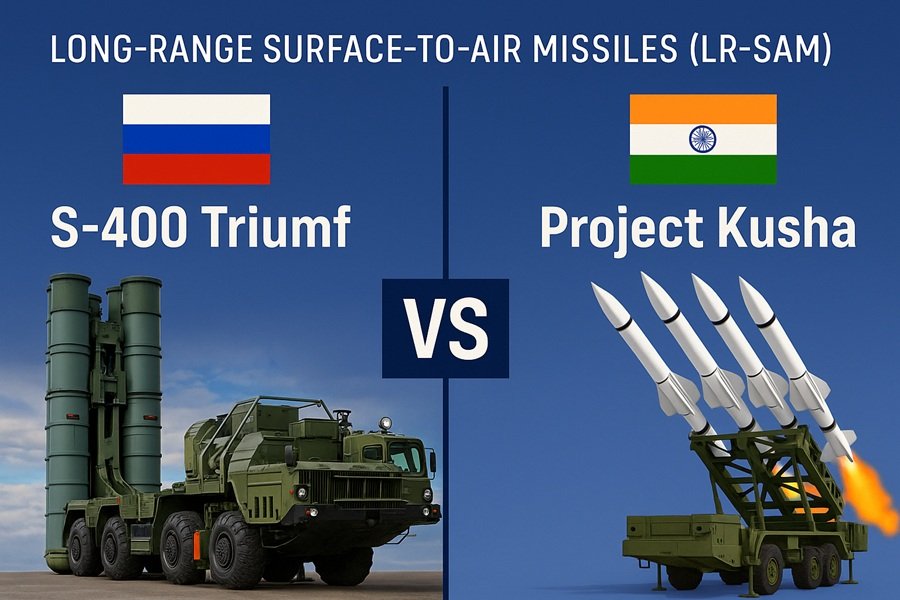
Introduction
In the modern age of aerial warfare, advanced air defence systems are critical for securing national airspace against enemy aircraft, drones, and ballistic threats. India, recognizing this strategic need, has been deploying foreign technologies like Russia’s S-400 Triumf while simultaneously developing its indigenous Project Kusha under the Defence Research and Development Organisation (DRDO). This article presents a comprehensive comparison between the S-400 system and Project Kusha, evaluating their capabilities, differences, advantages, and implications for India’s long-term defence strategy.
Overview of the S-400 Triumf
Origin: Russia
Developer: Almaz-Antey
Inducted by India: 2021 onwards (First system delivered under a 2018 deal)
The S-400 Triumf (NATO designation: SA-21 Growler) is considered one of the most advanced long-range surface-to-air missile (LR-SAM) systems in the world. With a proven track record in operational deployments, the S-400 can intercept and destroy a wide variety of aerial targets including fighter jets, UAVs, cruise missiles, and ballistic missiles.
Key Features:
- Detection Range: Up to 600 km
- Engagement Range: Up to 400 km (with 40N6 missile)
- Target Tracking: Simultaneous tracking of up to 300 targets
- Missile Types: 40N6, 48N6DM, 9M96E2, 9M96E
- Interceptor Speed: Mach 14+
- Deployment Time: 5–10 minutes
- Radars: 91N6E Big Bird acquisition radar, 92N6E Grave Stone engagement radar
Read This: India’s Air Defense System Explained: A Multi-Layered Shield Against Aerial Threats
Overview of Project Kusha
Origin: India
Developer: Defence Research and Development Organisation (DRDO)
Approved: 2022 | First test expected: 2025
Operational Deployment Goal: 2028–2029
Project Kusha is India’s answer to developing a desi S-400, aimed at replacing or supplementing foreign missile systems with an entirely indigenous LR-SAM solution. It’s a multi-tiered system designed to offer layered air defence against advanced threats including stealth aircraft, drones, precision-guided munitions (PGMs), and cruise missiles.
Key Features:
- Detection Range: Up to 600 km (estimated)
- Engagement Range:
- M1 missile: ~150 km
- M2 missile: ~250 km
- M3 missile: ~350 km
- Interceptor Speed: Mach 5.5+
- Kill Mechanism: Hit-to-kill + proximity fuse
- Guidance System: Dual-mode seeker (RF + IR)
- Integration: Fully integrated with India’s IACCS (Integrated Air Command and Control System)
S-400 vs Project Kusha: Head-to-Head Comparison
| Feature | S-400 Triumf (Russia) | Project Kusha (India) |
|---|---|---|
| Country of Origin | Russia | India (Indigenous) |
| Range (Max) | 400 km (40N6 missile) | 350 km (M3 interceptor) |
| Target Tracking | 300+ simultaneous targets | Estimated 100–150 (details classified) |
| Missile Speed | Up to Mach 14 | Up to Mach 5.5 |
| Radar Type | AESA, phased array | AESA with indigenous radar tech |
| Kill Probability | Very high (proven combat performance) | High (expected, under development) |
| Deployment | 5 delivered to India from Russia | 5 squadrons approved; delivery by ~2029 |
| Integration | Partial with IACCS | Full integration with IACCS |
| Unit Cost | Approx. $500M per unit | Estimated ₹4,300 Cr (~$520M) for 1 squadron |
| Technology Transfer | No full ToT | Full indigenous development |
| Maintenance & Lifecycle | Dependent on Russia | Entirely Indian-controlled |
Strategic Significance
🔹 S-400 Advantages:
- Proven system with global deployment experience
- Longer missile range (up to 400 km)
- Operational immediacy — India has already inducted 3–5 systems
- Strong ballistic missile interception capabilities
🔹 Project Kusha Advantages:
- Self-reliance and reduced dependency on imports
- Modular design allowing upgrades and tech evolution
- Cost-effectiveness in the long term (no foreign currency outflow)
- Custom-tailored for Indian terrain and threats
- Easier integration with Make-in-India defence infrastructure
Why Project Kusha Matters for India
- Strategic Autonomy: Reduces dependence on Russia, especially critical amidst geopolitical volatility.
- Custom Development: Tailored to Indian military needs and subcontinental threat scenarios.
- Export Potential: Once validated, Project Kusha can open up lucrative arms export markets in Southeast Asia, Africa, and the Middle East.
- Innovation Ecosystem: Boosts domestic R&D, manufacturing, and electronics ecosystems under the ‘Atmanirbhar Bharat’ initiative.
Challenges Ahead for Project Kusha
- Technology Maturity: While promising, the system is still in development and must undergo rigorous validation.
- Timelines: Delays in DRDO testing cycles can impact deployment by the targeted 2028–29 window.
- Budget Adherence: Managing a ₹21,700 crore budget within a complex supply chain is critical for timely success.
Conclusion: Complementary, Not Competitive
Rather than a simple rivalry, S-400 and Project Kusha are complementary systems in India’s air defence ecosystem. While the S-400 provides immediate high-level defence coverage, Project Kusha represents India’s technological leap toward self-reliant defence architecture.
As Project Kusha matures, India will likely be able to phase out foreign systems or reduce new imports, moving towards a fully indigenous, layered air defence capability. This evolution will be a cornerstone in asserting India’s position as a global defence technology power.





